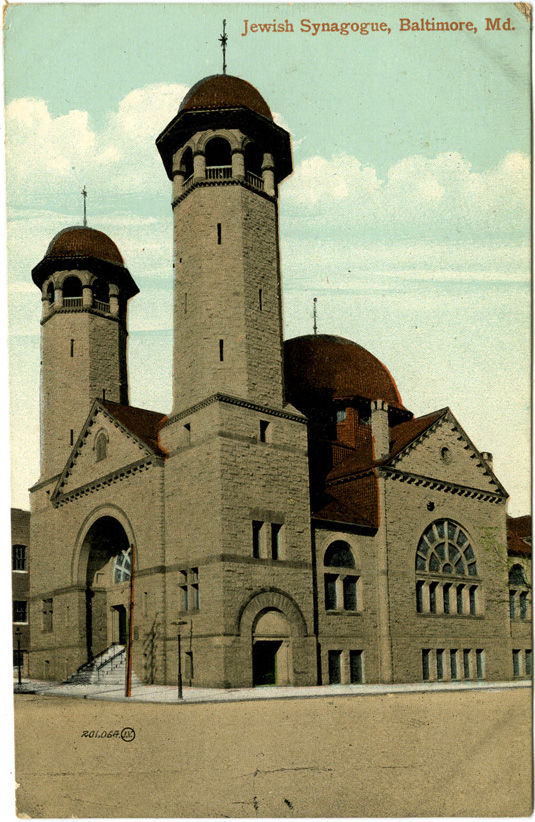5.1 Baltimore, Maryland
Baltimore Hebrew/Madison Avenue Temple, 1901 Madison Avenue
Charles Carson, architect, 1891
Valentine and Sons’ Publishing Company, New York, publisher; no date; also on back: “Printed in Great Britain”
In 1887, Baltimore Hebrew Congregation decided to leave its original downtown location in East Baltimore and move to Bolton Hill, an up-and-coming neighborhood of the city. After choosing a site at the corner of Madison Avenue and Roberts Street, the congregation hired prominent local architect Charles Carson to design the “Madison Avenue Temple,” whose construction ultimately cost some $150,000, equivalent to more than $4 million in 2020.
Carson had been supervising architect when buildings were added to Baltimore’s Lovely Lane Methodist Church, designed by Stanford White. Carson used local Port Deposit granite for rough, dark, heavy masonry and massing for both projects and chose Spanish roofing tiles in place of shingles.
The Madison Avenue Temple was the first among Baltimore’s synagogues to include a dome or towers, elements long popular elsewhere. A contemporary newspaper account described the building:
Taking its design from an oriental form that well accords with the origin of the religion in whose service it is built, the new temple . . . uplifts its massive walls and turrets, arches and domes in beautiful modern reproduction of the architecture of Byzantium. . . . The general effect of the beautiful structure as it meets the eye from its commanding position . . . is one of dignity and repose, the massive proportions suggesting grandeur in simplicity in every outline of round arch, pointed gable and octagonal tower.1
According to historian David Kaufman:
The scope of the project is remarkable given the size of the congregation at the time. In 1887, Baltimore Hebrew Congregation comprised just 63 adult male members, yet the new temple was built to seat over 1,000 worshippers! The cornerstone-laying took place in July 1890, and dedication ceremonies were held in September 1891. By the time Baltimore Hebrew Congregation joined the Reform Movement’s Union of American Hebrew Congregations in 1892, the vision of the congregation’s leadership had been fulfilled—a magnificent temple was built, the membership was burgeoning, and the prestige of the congregation was restored.2
The move reflected the uptown migration of affluent Jews of German descent away from an area filling with waves of Eastern European immigrants. The old synagogues would be sold to new congregations, and the elegant houses of the established elite would be broken into flats.
1 “A Byzantine Temple,” Baltimore Sun, supplement, September 25, 1891.
2 David Kaufman, “Cornerstones of Community: The Historic Synagogues of Maryland,” in Cornerstones of Community: The Historic Synagogues of Maryland, 1845-1945. (Baltimore: Jewish Museum of Maryland, 1999), 31.
